初一下册英语辅导资料.doc
- 格式:doc
- 大小:26.50 KB
- 文档页数:4
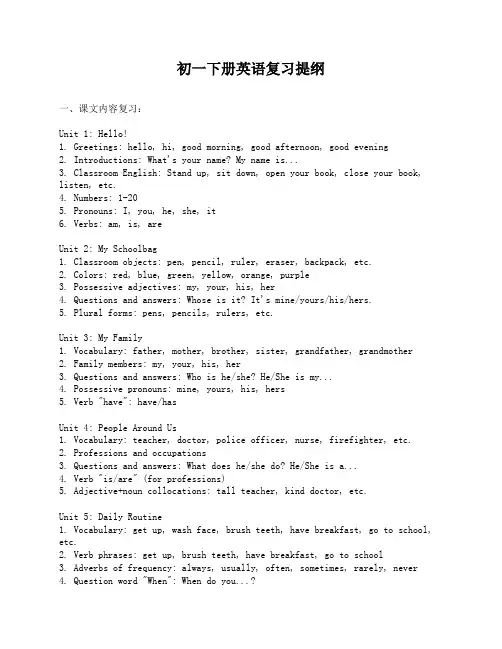
初一下册英语复习提纲一、课文内容复习:Unit 1: Hello!1. Greetings: hello, hi, good morning, good afternoon, good evening2. Introductions: What's your name? My name is...3. Classroom English: Stand up, sit down, open your book, close your book, listen, etc.4. Numbers: 1-205. Pronouns: I, you, he, she, it6. Verbs: am, is, areUnit 2: My Schoolbag1. Classroom objects: pen, pencil, ruler, eraser, backpack, etc.2. Colors: red, blue, green, yellow, orange, purple3. Possessive adjectives: my, your, his, her4. Questions and answers: Whose is it? It's mine/yours/his/hers.5. Plural forms: pens, pencils, rulers, etc.Unit 3: My Family1. Vocabulary: father, mother, brother, sister, grandfather, grandmother2. Family members: my, your, his, her3. Questions and answers: Who is he/she? He/She is my...4. Possessive pronouns: mine, yours, his, hers5. Verb "have": have/hasUnit 4: People Around Us1. Vocabulary: teacher, doctor, police officer, nurse, firefighter, etc.2. Professions and occupations3. Questions and answers: What does he/she do? He/She is a...4. Verb "is/are" (for professions)5. Adjective+noun collocations: tall teacher, kind doctor, etc.Unit 5: Daily Routine1. Vocabulary: get up, wash face, brush teeth, have breakfast, go to school, etc.2. Verb phrases: get up, brush teeth, have breakfast, go to school3. Adverbs of frequency: always, usually, often, sometimes, rarely, never4. Question word "When": When do you...?5. Time expressions: in the morning, in the afternoon, in the eveningUnit 6: Leisure Time1. Vocabulary: read, draw, play chess, play basketball, watch TV, etc.2. Verb phrases for leisure activities3. Questions and answers: What do you like to do? I like to...4. Verb "like" (for hobbies)5. Present continuous tense: am/is/are + verb+ing (playing, reading, etc.)二、语法知识复习:1. Simple present tense: am/is/are, do/does- Positive, negative, and interrogative sentences- Third person singular forms (he, she, it)- Adverbs of frequency- Time expressions: always, usually, often, sometimes, rarely, never2. Possessive adjectives and pronouns- my, your, his, her, its, our, their- mine, yours, his, hers, its, ours, theirs3. Plural forms of nouns- Regular plurals: add -s (books, pens)- Irregular plurals: child-children, person-people4. Verb "have"- I have, you have, he/she/it has, we have, they have- Possessive forms: have/has + noun phrase (I have a pen, she has a book)5. Verb "do" for general actions/habits- I do, you do, he/she/it does, we do, they do- Questions and negative forms6. Verb "be"- am/is/are (I am, he/she/it is, we/they are)- Positive, negative, and interrogative sentences7. Present continuous tense- am/is/are + verb+ing (I am playing, he is reading, etc.)- Positive, negative, and interrogative sentences- Adverbs of frequency三、听力训练:1. 听录音选择正确的单词或图片。
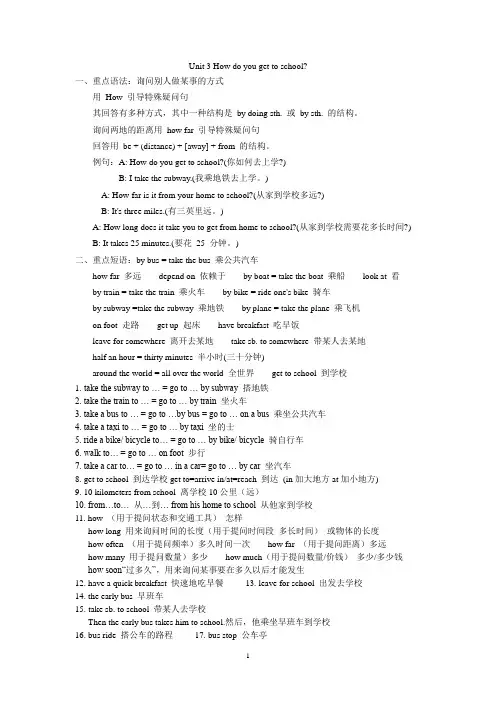
Unit 3 How do you get to school?一、重点语法:询问别人做某事的方式用How 引导特殊疑问句其回答有多种方式,其中一种结构是by doing sth. 或by sth. 的结构。
询问两地的距离用how far 引导特殊疑问句回答用be + (distance) + [away] + from 的结构。
例句:A: How do you get to school?(你如何去上学?)B: I take the subway.(我乘地铁去上学。
)A: How far is it from your home to school?(从家到学校多远?)B: It's three miles.(有三英里远。
)A: How long does it take you to get from home to school?(从家到学校需要花多长时间?) B: It takes 25 minutes.(要花25 分钟。
)二、重点短语:by bus = take the bus 乘公共汽车how far 多远depend on 依赖于by boat = take the boat 乘船look at 看by train = take the train 乘火车by bike = ride one's bike 骑车by subway =take the subway 乘地铁by plane = take the plane 乘飞机on foot 走路get up 起床have breakfast 吃早饭leave for somewhere 离开去某地take sb. to somewhere 带某人去某地half an hour = thirty minutes 半小时(三十分钟)around the world = all over the world 全世界get to school 到学校1.take the subway to … = go to … by subway 搭地铁2. take the train to … = go to … by train 坐火车3. take a bus to … = go to …by bus = go to … on a bus 乘坐公共汽车4. take a taxi to … = go to … by taxi 坐的士5. ride a bike/ bicycle to… = go to … by bike/ bicycle 骑自行车6. walk to… = go to … on foot 步行7. take a car to… = go to … in a car= go to … by car 坐汽车8. get to school 到达学校get to=arrive in/at=reach 到达(in加大地方at加小地方)9. 10 kilometers from school 离学校10公里(远)10. from…to… 从…到… from his home to school 从他家到学校11. how (用于提问状态和交通工具)怎样how long 用来询问时间的长度(用于提问时间段多长时间)或物体的长度how often (用于提问频率)多久时间一次how far (用于提问距离)多远how many 用于提问数量)多少how much(用于提问数量/价钱)多少/多少钱how soon“过多久”,用来询问某事要在多久以后才能发生12. have a quick breakfast 快速地吃早餐13. leave for school 出发去学校14. the early bus 早班车15.take sb. to school 带某人去学校Then the early bus takes him to school.然后,他乘坐早班车到学校16. bus ride 搭公车的路程17. bus stop 公车亭18. bus station 公车站bus stop 是指小站,bus station指大的站,比如汽车站。
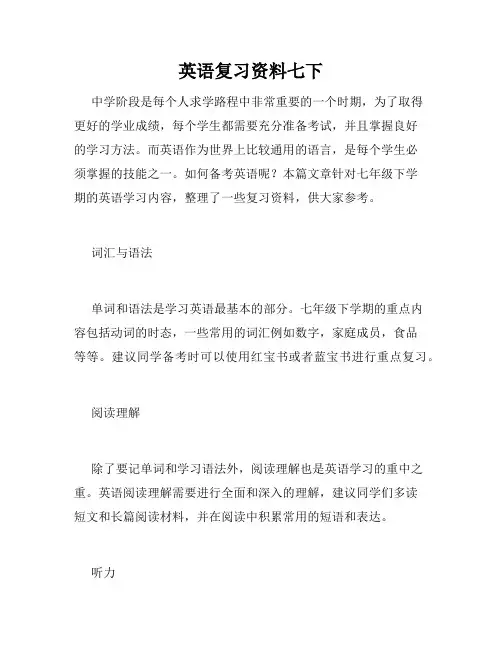
英语复习资料七下中学阶段是每个人求学路程中非常重要的一个时期,为了取得更好的学业成绩,每个学生都需要充分准备考试,并且掌握良好的学习方法。
而英语作为世界上比较通用的语言,是每个学生必须掌握的技能之一。
如何备考英语呢?本篇文章针对七年级下学期的英语学习内容,整理了一些复习资料,供大家参考。
词汇与语法单词和语法是学习英语最基本的部分。
七年级下学期的重点内容包括动词的时态,一些常用的词汇例如数字,家庭成员,食品等等。
建议同学备考时可以使用红宝书或者蓝宝书进行重点复习。
阅读理解除了要记单词和学习语法外,阅读理解也是英语学习的重中之重。
英语阅读理解需要进行全面和深入的理解,建议同学们多读短文和长篇阅读材料,并在阅读中积累常用的短语和表达。
听力英语口语和听力是英语学习的另两个基本部分。
为了提高自己的听力能力,建议同学们多听一些英语歌曲,广播,电视节目或者相应的录音资料。
听力训练对于掌握英语发音,语速和表达方式都非常有帮助。
其他学习资源英语作为全球通用的语言,对于学生来说相关的学习资源也非常丰富。
学习英语需要使用不同的方法和资源,以便更好更轻松地掌握语法,单词和其他各种技能。
一些有用的学习资源如下:1. Duolingo –免费的在线语言学习工具。
2. 学而思网校–一个提供在线辅导和备考材料的大型教育品牌。
3. Quizlet –一款免费的在线外语学习应用,集合了语法,单词,口语等等学习资源。
4. YouTube –在YouTube上有各种英语学习频道,学生们可以订阅来获得有用的学习技巧,并且通过评论和点赞让其他同学互相交流。
总之,英语学习需要坚持不懈的练习和学习,并且积累巨大的时间和精力。
掌握好基本的语法和单词,经常进行语言的实践和交流,还有选择合适的学习资源,都是取得好成绩的关键。

人教版七年级下册英语总复习
目标
本文档旨在提供人教版七年级下册英语的总复材料,帮助学生回顾和巩固所学内容。
复内容
1. 单元一:Lesson 1-2
- 研究日常问候语和自我介绍的表达方式
- 研究数字1-100及其应用
- 研究询问和回答年龄的方式
2. 单元二:Lesson 3-4
- 研究询问和表达家庭成员关系的方式
- 研究询问和回答职业的方式
- 研究指示方向和位置的表达方式
3. 单元三:Lesson 5-6
- 研究描述人物外貌和性格特征的表达方式
- 研究询问和回答时间的方式
- 研究表示频率的副词及其应用
4. 单元四:Lesson 7-8
- 研究描述人物喜好和日常活动的表达方式- 研究询问和回答能力和兴趣的方式
- 研究表达原因和结果的连词及其应用
5. 单元五:Lesson 9-10
- 研究描述家庭、房间和城市的表达方式- 研究询问和表达地点的方式
- 研究表示数量和价格的词汇及其应用
6. 单元六:Lesson 11-12
- 研究询问和回答日程安排的方式
- 研究表达喜怒和感受的形容词及其应用- 研究询问和表达能力和意愿的方式
复建议
- 复每个单元的重点词汇和常用句型
- 做相关单元的练题和听力练
- 跟读课文,注意语音和语调的准确性
- 制作复笔记,总结重点内容和常见问题- 参加口语练和模拟对话
祝愿同学们复习顺利,考试取得好成绩!。
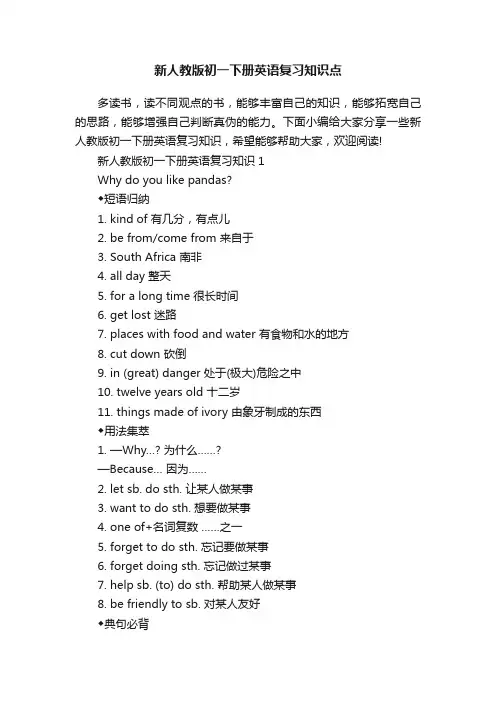
新人教版初一下册英语复习知识点多读书,读不同观点的书,能够丰富自己的知识,能够拓宽自己的思路,能够增强自己判断真伪的能力。
下面小编给大家分享一些新人教版初一下册英语复习知识,希望能够帮助大家,欢迎阅读!新人教版初一下册英语复习知识1Why do you like pandas?◆短语归纳1. kind of 有几分,有点儿2. be from/come from 来自于3. South Africa 南非4. all day 整天5. for a long time 很长时间6. get lost 迷路7. places with food and water 有食物和水的地方8. cut down 砍倒9. in (great) danger 处于(极大)危险之中10. twelve years old 十二岁11. things made of ivory 由象牙制成的东西◆用法集萃1. —Why…? 为什么……?—Because… 因为……2. let sb. do sth. 让某人做某事3. want to do sth. 想要做某事4. one of+名词复数……之一5. forget to do sth. 忘记要做某事6. forget doing sth. 忘记做过某事7. help sb. (to) do sth. 帮助某人做某事8. be friendly to sb. 对某人友好◆典句必背1. —Why do you like pandas? 你为什么喜欢熊猫?—Because they’re kind of interesting. 因为它们有点儿有趣。
2. —Why does John like koalas? 约翰为什么喜欢树袋熊?—Because they’re very cute. 因为它们非常可爱。
3. —Why don’t you like tigers? 你为什么不喜欢老虎?—Because they’re really scary. 因为它们真的吓人。
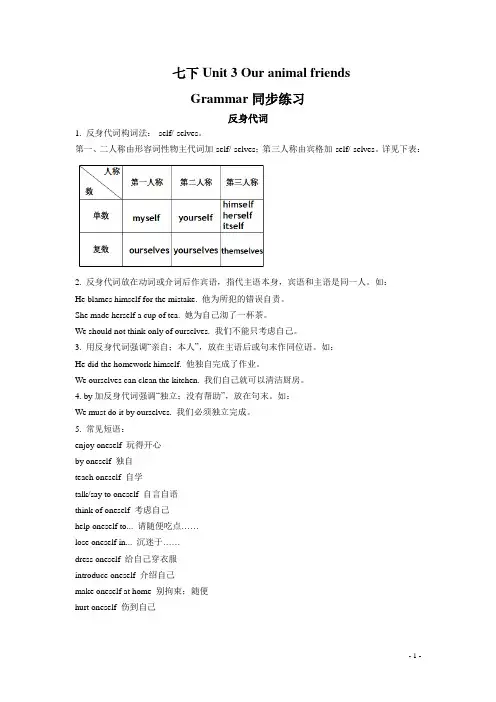
七下Unit 3 Our animal friendsGrammar同步练习反身代词1. 反身代词构词法:-self/-selves。
第一、二人称由形容词性物主代词加-self/-selves;第三人称由宾格加-self/-selves。
详见下表:2. 反身代词放在动词或介词后作宾语,指代主语本身,宾语和主语是同一人。
如:He blames himself for the mistake. 他为所犯的错误自责。
She made herself a cup of tea. 她为自己沏了一杯茶。
We should not think only of ourselves. 我们不能只考虑自己。
3. 用反身代词强调“亲自;本人”,放在主语后或句末作同位语。
如:He did the homework himself. 他独自完成了作业。
We ourselves can clean the kitchen. 我们自己就可以清洁厨房。
4. by加反身代词强调“独立;没有帮助”,放在句末。
如:We must do it by ourselves. 我们必须独立完成。
5. 常见短语:enjoy oneself 玩得开心by oneself 独自teach oneself 自学talk/say to oneself 自言自语think of oneself 考虑自己help oneself to... 请随便吃点……lose oneself in... 沉迷于……dress oneself 给自己穿衣服introduce oneself 介绍自己make oneself at home 别拘束;随便hurt oneself 伤到自己方位介词方位介词就是用来表示方位的介词。
中学阶段比较重要的方位介词有:1. in在大地方; at 在小地方。
如:He arrived in Shenzhen yesterday. 他昨天到了深圳。
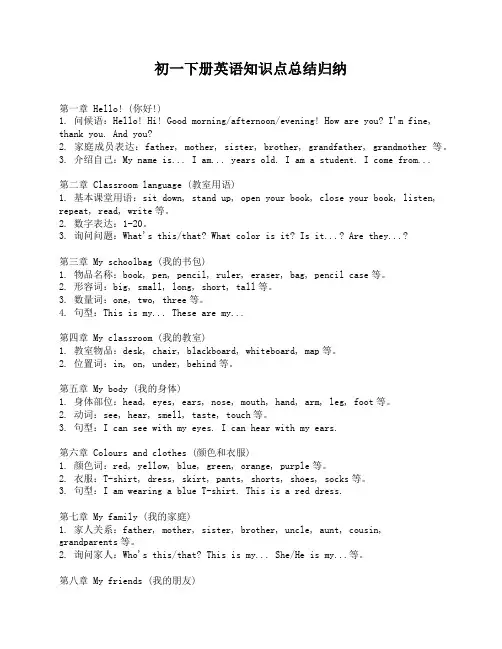
初一下册英语知识点总结归纳第一章 Hello! (你好!)1. 问候语:Hello! Hi! Good morning/afternoon/evening! How are you? I'm fine, thank you. And you?2. 家庭成员表达:father, mother, sister, brother, grandfather, grandmother等。
3. 介绍自己:My name is... I am... years old. I am a student. I come from...第二章 Classroom language (教室用语)1. 基本课堂用语:sit down, stand up, open your book, close your book, listen, repeat, read, write等。
2. 数字表达:1-20。
3. 询问问题:What's this/that? What color is it? Is it...? Are they...?第三章 My schoolbag (我的书包)1. 物品名称:book, pen, pencil, ruler, eraser, bag, pencil case等。
2. 形容词:big, small, long, short, tall等。
3. 数量词:one, two, three等。
4. 句型:This is my... These are my...第四章 My classroom (我的教室)1. 教室物品:desk, chair, blackboard, whiteboard, map等。
2. 位置词:in, on, under, behind等。
第五章 My body (我的身体)1. 身体部位:head, eyes, ears, nose, mouth, hand, arm, leg, foot等。

初一开学考复习第一课Part I. Grammar 语法。
(三篇语法填空,限时10min)(A)阅读下面短文,在空格处填入一个适当的司或使用括号中词语的正确形式填空。
Peter was an English boy. His hobby was 59. (collect) stamps. He had stamps from many 60. (country). Peter’s favourite stamps came from France. He had every French edition except a 1984 special edition stamp. It was very hard to find it. He looked for it everywhere. He asked his friends and relatives to help him, 61. nobody could find the stamp. It made Peter very sad.“Don’t worry. If you have patience (耐心), you 62. (find) it one day.” his father said to him.“I hope so.” Peter said. Peter also liked making friends. He had a pen friend named Victor and he was in France. They 63.(write) to each other every month. One day, Victor’s mother gave him 64. old French stamp. Victor used it to post a letter to Peter.When Peter got the letter, he looked 65. (careful) at the stamp. He was very happy to see it was the 1984 special edition stamp. He told the good news to 66. (he) family.“You see,” his father said, “you did find your stamp in the end. So you know, it’s good 67. (have) two things in life.”“68. are they?” Peter asked. “Friends and patience!” his father answered.(B)阅读下面短文,在空格处填入一个适当的司或使用括号中词语的正确形式填空。
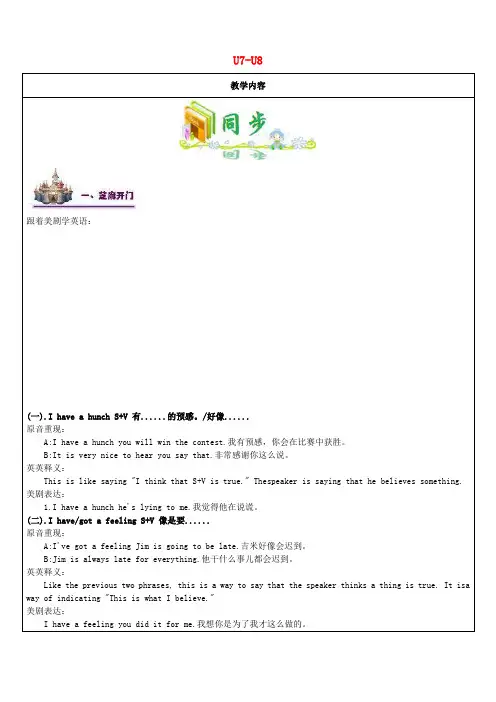
U7-U8教学内容跟着美剧学英语:(一).I have a hunch S+V 有......的预感。
/好像......原音重现:A:I have a hunch you will win the contest.我有预感,你会在比赛中获胜。
B:It is very nice to hear you say that.非常感谢你这么说。
英英释义:This is like saying "I think that S+V is true." Thespeaker is saying that he believes something. 美剧表达:1.I have a hunch he's lying to me.我觉得他在说谎。
(二).I have/got a feeling S+V 像是要......原音重现:A:I've got a feeling Jim is going to be late.吉米好像会迟到。
B:Jim is always late for everything.他干什么事儿都会迟到。
英英释义:Like the previous two phrases, this is a way to say that the speaker thinks a thing is true. It isa way of indicating "This is what I believe."美剧表达:I have a feeling you did it for me.我想你是为了我才这么做的。
Unit7知识点1:giving a seat to someone on the bus(P81) 在公交车上给人让座seat名词,意为“座位”,give a seat to sb. 给某人让座,也可表达为give seats to sb.There is no seat on the bus. 公交车上没有座位了。
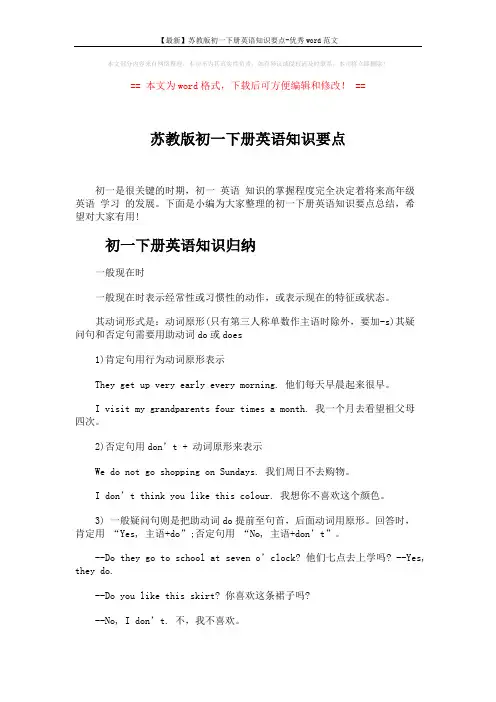
本文部分内容来自网络整理,本司不为其真实性负责,如有异议或侵权请及时联系,本司将立即删除!== 本文为word格式,下载后可方便编辑和修改! ==苏教版初一下册英语知识要点初一是很关键的时期,初一英语知识的掌握程度完全决定着将来高年级英语学习的发展。
下面是小编为大家整理的初一下册英语知识要点总结,希望对大家有用!初一下册英语知识归纳一般现在时一般现在时表示经常性或习惯性的动作,或表示现在的特征或状态。
其动词形式是:动词原形(只有第三人称单数作主语时除外,要加-s)其疑问句和否定句需要用助动词do或does1)肯定句用行为动词原形表示They get up very early every morning. 他们每天早晨起来很早。
I visit my grandparents four times a month. 我一个月去看望祖父母四次。
2)否定句用don’t + 动词原形来表示We do not go shopping on Sundays. 我们周日不去购物。
I don’t think you like this colour. 我想你不喜欢这个颜色。
3) 一般疑问句则是把助动词do提前至句首,后面动词用原形。
回答时,肯定用“Yes, 主语+do”;否定句用“No, 主语+don’t”。
--Do they go to school at seven o’clock? 他们七点去上学吗? --Yes, they do.--Do you like this skirt? 你喜欢这条裙子吗?--No, I don’t. 不,我不喜欢。
一般现在时用来表示经常的或习惯性的动作,常与以下的时间状语连用:often 经常,always 总是,sometimes 有时,usually 通常,every day/ week 每天/ 周等。
He usually goes to school by bike. 通常他骑车上学。
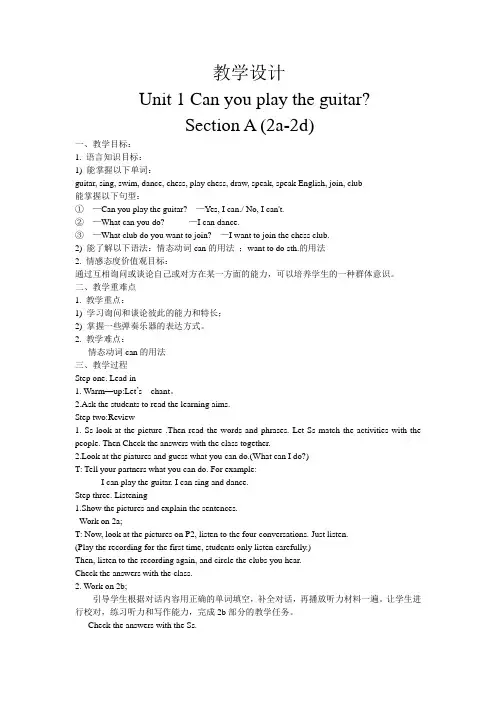
教学设计Unit 1 Can you play the guitar?Section A (2a-2d)一、教学目标:1. 语言知识目标:1) 能掌握以下单词:guitar, sing, swim, dance, chess, play chess, draw, speak, speak English, join, club能掌握以下句型:①—Can you play the guitar? —Yes, I can./ No, I can't.②—What can you do? —I can dance.③—What club do you want to join? —I want to join the chess club.2) 能了解以下语法:情态动词can的用法;want to do sth.的用法2. 情感态度价值观目标:通过互相询问或谈论自己或对方在某一方面的能力,可以培养学生的一种群体意识。
二、教学重难点1. 教学重点:1) 学习询问和谈论彼此的能力和特长;2) 掌握一些弹奏乐器的表达方式。
2. 教学难点:情态动词can的用法三、教学过程Step one. Lead in1. Warm—up:Let’s chant。
2.Ask the students to read the learning aims.Step two:Review1. Ss look at the picture .Then read the words and phrases. Let Ss match the activities with the people. Then Check the answers with the class together.2.Look at the piatures and guess what you can do.(What can I do?)T: Tell your partners what you can do. For example:I can play the guitar. I can sing and dance.Step three. Listening1.Show the pictures and explain the sentences.Work on 2a;T: Now, look at the pictures on P2, listen to the four conversations. Just listen.(Play the recording for the first time, students only listen carefully.)Then, listen to the recording again, and circle the clubs you hear.Check the answers with the class.2. Work on 2b;引导学生根据对话内容用正确的单词填空,补全对话,再播放听力材料一遍。
七年级英语(下)UNIT(1-6)复习提纲Unit 1 Where’s your pen pal from?一.短语:1 .be from = come from 来自于---- 2. live in 居住在--- 3. on weekends 在周末4 .write to sb = write a letter to sb 给某人写信;写信给某人5 .in the world 在世界上 6.in China 在中国 7.pen pal 笔友8. 14 years old 14岁 9.favorite subject 最喜欢的科目10.the United States 美国the United Kingdom 英国New York 纽11.speak English 讲英语like and dislike 爱憎9.go to the movies 去看电影play sports 做运动二.重点句式:1 Where’s your pen pal from? = Where does your pen pal from/2 Where does he live?3 What language(s) does he speak?4 I want a pen pal in China.5 I can speak English and a little French.6 Please write and tell me about yourself.7 Can you write to me soon? 8 I like going to the movies with my friends and playing sports.三.本单元的国家,人民、言语对应。
1 Canada---- Canadian---- English / French 2France------ French------French3 Japan------Japanese----Japanese4 Australia----Australian----- English5 the United States------ American---- English6 the United Kingdom---British----- EnghishUnit 2 Where’s the post office?一.A sking ways: (问路)1.Where is (the nearest) ……?(比来的)……在哪里?2.Can you tell me the way to ……?你能告诉我去……的路吗?3.How can I get to ……?我怎样到达……呢?4.Is there …… near here / in the neighborhood? 附近有……吗?5.Which is the way to ……?哪条是去……的路?二.Showing the ways: (指路)1. Go straight down / along this street. 沿着这条街不断走。
初一英语七年级下册重点语法归纳附学习方法一. 情态动词can的用法can+动词原形,它不随主语的人称和数而变化。
1. 含有can的肯定句:主语+can+谓语动词的原形+其他。
2. 含有can的否定句:主语+can't+动词的原形+其他。
3. 变一般疑问句时,把can提前:Can+主语+动词原形+其他?肯定回答:Yes,主语+can。
否定回答:No,主语+can't.4. 含有can的特殊疑问句:特殊疑问词+can+主语+动词原形+其他?I can speak English.→I can't speak English.→Can you speak English? →What can you speak?二. what time和when引导的特殊疑问句1. 询问钟点时用what time,询问日期、月份、年份时用when。
2. What's the time?=What time is it?现在几点了?3. 时刻表达法:顺读法和逆读法。
顺读法:“钟点+分钟”直接读数字。
如:7: 05 seven five;8:16 eight sixteen逆读法:借助介词past或to表示,要先说分再说钟点。
a. 当分钟不超过30分钟时(包括30分钟),即<或=30,用past表示。
其结构为:“分钟+past+整点”意为“几点过几分”。
如:1:25 twenty-five past oneb. 当超过30分钟时,即>30,用to表示。
其结构为:“所差分钟(即60—所过分钟数)+to+下一个整点”,to译成“差”,差几分钟到几点。
如:4:38 twenty-two to fivec. 当分钟为30分钟用half表示,当分钟为15分钟用a quarter。
三. how引导的特殊疑问句1. how 引导的特殊疑问句提问交通方式,其答语分三种情况:a. take a/an/the+交通工具(单数)b. by+交通工具(单数)c. on/in+限定词+交通工具---How do you go to school every day?---I take a bus to go to school every day./I go to school by bus every day./I go to school on the bus every day.2. how far 用来提问距离,多远,其答语分为两种:(1)用长度单位表示:It is five kilometers.(2)用时间表示:It’s twenty minutes’walk.3. how long 用来提问时间,意为多久回答常用“for+段时”。
七年级英语下册-全册知识点梳理以下是七年级英语下册的全册知识点梳理:
1. 单元一:研究方法
- 研究英语的方法和技巧
- 词汇积累和记忆技巧
- 多听多说多读多写的重要性
2. 单元二:我的朋友
- 描述人物特征和外貌
- 询问和回答关于朋友的问题
- 谈论个人喜好和兴趣爱好
3. 单元三:买东西
- 研究购物相关的词汇和句子
- 懂得如何询问价格和付款方式
- 学会表达自己的购物意愿和偏好4. 单元四:我的学校
- 研究学校相关的词汇和句子
- 描述学校和课堂环境
- 谈论研究内容和学科
5. 单元五:我的生活
- 研究日常生活相关的词汇和句子- 描述自己的生活惯和家庭
- 谈论日常活动和时间安排
6. 单元六:我的假期
- 研究度假和旅行相关的词汇和句子- 描述过去和将来的假期计划
- 谈论旅行经历和感受
7. 单元七:我喜欢运动
- 研究运动项目和运动器材的词汇
- 喜欢和不喜欢的表达方式
- 谈论个人的体育运动经验和兴趣爱好
这份文档梳理了七年级英语下册的全册知识点,希望对你的学习有所帮助。
初一下册人教版英语知识点一、词汇学习词汇是语言的基础,初一下册人教版英语教材涵盖了各类实用、常见词汇。
学生应熟练掌握以下几类词汇:1. 日常生活词汇:如家具、衣物、食品、交通工具等,如table(桌子)、coat(外套)、banana(香蕉)、bus(公共汽车)等。
2. 学校生活词汇:如学科名称、学习用品、校园设施等,如math(数学)、pen(钢笔)、library(图书馆)等。
3. 情感与态度表达词汇:如各种情绪形容词、态度动词及短语,如happy(快乐的)、sad(悲伤的)、hope(希望)、dislike(不喜欢)等。
4. 时间与日期表达词汇:如星期、月份、季节、时间点等,如Monday(星期一)、July(七月)、spring(春天)、3 o'clock (三点钟)等。
二、语法知识初一下册英语教材进一步深化学生的语法知识,主要包括:1. 一般现在时态:用于描述习惯性动作、客观事实或真理,如She always gets up early.(她总是早起。
)2. 一般过去时态:用于叙述过去发生的具体事件,如Yesterday I went to the park.(昨天我去公园了。
)3. 现在进行时态:表示正在进行的动作或现阶段持续的状态,如They are playing basketball now.(他们现在正在打篮球。
)4. 一般将来时态:用于预测未来或计划要做的事情,如We will visit my grandparents next weekend.(我们下周末将去看望我的祖父母。
)5. There be 句型:表示某处存在某物或某人,如There isa big tree in front of our house.(我们的房子前面有一棵大树。
)6. 介词短语:用于表示时间、地点、方式等,如at school (在学校)、on Monday(在星期一)、by bus(乘公交车)等。
初一英语下册语法知识点全汇总English Grammar Points for Grade 7 Lower Textbook**一、基本句型结构****Basic Sentence Structures**1. **主语 + 谓语 (S + V)*** Example: She sings. * 中文示例:她唱歌。
2. **主语 + 谓语 + 宾语 (S + V + O)*** Example: I have a cat. * 中文示例:我有一只猫。
3. **主语 + 谓语 + 间接宾语 + 直接宾语 (S + V + IO + DO)*** Example: My mom gave me a book. * 中文示例:我妈妈给了我一本书。
4. **主语 + 谓语 + 宾语 + 宾语补足语 (S + V + O + OC)*** Example: They call him Tom. * 中文示例:他们叫他汤姆。
**二、时态****Tenses**1. **一般现在时 (Present Simple)*** Example: I go to school every day. * 中文示例:我每天上学。
2. **现在进行时 (Present Continuous)*** Example: She is studying now. * 中文示例:她现在正在学习。
3. **一般过去时 (Past Simple)*** Example: They played football yesterday. * 中文示例:他们昨天踢足球了。
4. **过去进行时 (Past Continuous)*** Example: He was watching TV at that time. * 中文示例:他当时正在看电视。
**三、被动语态****Passive Voice*** Example: The book was written by him. * 中文示例:这本书是他写的。
初一下册英语辅导资料
注意:
1)有些动词一般不用于现在进行时,如see,like,love, want,know等,而用一般现在时。
如,Do you know him?你认识他吗?
2)有些动词如come, go, arrive, leave, start, fly, drive,stay等表示位置转移的词,用现在进行时表示按计划即将发生的动作,如 We are going to Beijing on Friday.我们星期五要去北京。
3.构词知识:
1) 名词后缀:-er,如,singer
-or,如 actor
-ing, 如 meeting
-tion 如 direction
2) 形容词后缀: -ful 如,beautiful
-ing 如,boring
-ous 如,dangerous
-ly 如, friendly
3)副词后缀:-ly 如,really
4)数词后缀:-teen 如,thirteen
-ty 如,thirty
-th 如,fourth
5)在国家名词后加-ian,-an, -n表示其国家的人。
如,
Egypt埃及 Egyptian埃及人
Europe欧洲 European欧洲人
Canada加拿大 Canadian加拿大人
Italy意大利 Italian意大利人
Australia澳大利亚 Australian澳大利亚人
America美国 American美国人
6)在表示天气的名词后加-y如,wind-windy, fog-foggy,sun-sunny
4. Until的用法:
Until 和 till的意义相同,都有“直到”,“直到...才","在...以前不"的意思.它们的使用方法为:
1) 作介词: 作介词,后面通常接表时间的名词或短语.如We are back until/till3o’clock.三点种我们才回来.
2) 作连词:作连词时,until和till引导时间状语从句.如Go along this road until you see the park沿着这条路走,直到你看到公园为止。
【注意】1)以上的状语从句的例句都是从句在主句之后,如果把从句放在主句之前,那么,引导词用till.如Till you come back, I won’t leavehere.直到你回来我才回离开这。
3)主句的动作是终止性的,要用not…until/till句型。
5.“违反规矩“的现在进行时态
1) 现在进行时比哦按时目前这一段时间内的活动或现阶段正
在进行的动作。
而说话时并不一定正在进行。
如Is Tom working hard this term?汤姆这学期学习用功吗?
They are working on the farm these days.这些日子他们在农场劳动。
2) 表示往返或位置转移的动词,如come,go,leave, stay, start, arrive等构成的现在进行时,可表示按计划或安排即将发生的动作。
这些动词还可以和表示将来的时间状语,如tomorrow, next week, next year等连用。
They are leaving for Beijing tomorrow.明天他们要动身去北京。
4)现在进行时与always, often等词相结合,也可表示习惯的,经常重复的动作。
意思是“老是”,“总是”。
此时常带有一定的感情色彩,如:埋怨,赞赏等。
如
Mary is always talking about her son.玛利总是谈论她的儿子。
【注意】一些表示状态和意愿的动词,如be,like,want,know ,think,have等,不能用于现在进行时态中。
如,
I want to go home now.
6. 关于how 的用法
1) How作“(指程度)多少”“(方法)怎样”“多么”讲,为副词。
2) how 的感叹句的构成:How + 形容词+主语+be动词!
How+副词+主语+谓语动词!
3)how many 多少(对可数名词的数量提问,其后接名词复数) How many days are there in a year?
4) how much 多少(钱)(对不可数名词的数量提问,其后接不可数名词)
How much water is there in the cup?
How much are these pants?
5) how often多久(对表示频度副词的时间状语提问)
How often do you go there? Once a month.
6)how old多大岁数(对年龄提问)
How old is your grandfather? He is sixty-five.
7)how soon多久(用于将来时)
How soon are you back? In a week.。